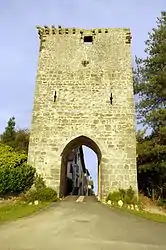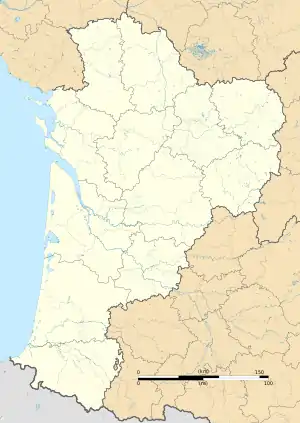Hastingues | |
|---|---|
 Gate of Hastingues from the 14th century | |
Location of Hastingues | |
 Hastingues  Hastingues | |
| Coordinates: 43°32′07″N 1°08′52″W / 43.5353°N 1.1478°W | |
| Country | France |
| Region | Nouvelle-Aquitaine |
| Department | Landes |
| Arrondissement | Dax |
| Canton | Orthe et Arrigans |
| Intercommunality | Pays d'Orthe et Arrigans |
| Government | |
| • Mayor (2020–2026) | Corine de Passos[1] |
| Area 1 | 14.54 km2 (5.61 sq mi) |
| Population | 601 |
| • Density | 41/km2 (110/sq mi) |
| Time zone | UTC+01:00 (CET) |
| • Summer (DST) | UTC+02:00 (CEST) |
| INSEE/Postal code | 40120 /40300 |
| Elevation | 0–84 m (0–276 ft) (avg. 44 m or 144 ft) |
| 1 French Land Register data, which excludes lakes, ponds, glaciers > 1 km2 (0.386 sq mi or 247 acres) and river estuaries. | |
Hastingues (French pronunciation: [astɛ̃ɡ]; Occitan: Hastings, Basque: Hastinga) is a commune in the Landes department in Nouvelle-Aquitaine in southwestern France.[3] Its nickname, due to its location on a rounded-shaped hill, is Lou Carcolh (the snail).
Geography
The town lies on a hill looking over the valley of the Gaves réunis, in the Gascon region and bordering on the Basque Country.
History
The bastide was founded in 1289 by John Hastings, seneschal of Gascony, who signed a treaty of coregency in the name of Edward I of England between the king, Duke of Aquitaine and the monks of Arthous abbey.
The work on the gate was started in 1289, but the town wall still was not complete in the 15th century.
The houses of Jurats and Sénéchal were built in the same century.
Population
| Year | Pop. | ±% p.a. |
|---|---|---|
| 1968 | 401 | — |
| 1975 | 408 | +0.25% |
| 1982 | 447 | +1.31% |
| 1990 | 472 | +0.68% |
| 1999 | 447 | −0.60% |
| 2009 | 583 | +2.69% |
| 2014 | 575 | −0.28% |
| 2020 | 598 | +0.66% |
| Source: INSEE[4] | ||
 View from the town over the valley and the river
View from the town over the valley and the river Maison Jurats
Maison Jurats House of the Seneschal
House of the Seneschal Entrance of the house of the Seneschal
Entrance of the house of the Seneschal Detail of the gate
Detail of the gate
References
- ↑ "Répertoire national des élus: les maires" (in French). data.gouv.fr, Plateforme ouverte des données publiques françaises. 13 September 2022.
- ↑ "Populations légales 2021". The National Institute of Statistics and Economic Studies. 28 December 2023.
- ↑ INSEE commune file
- ↑ Population en historique depuis 1968, INSEE
See also